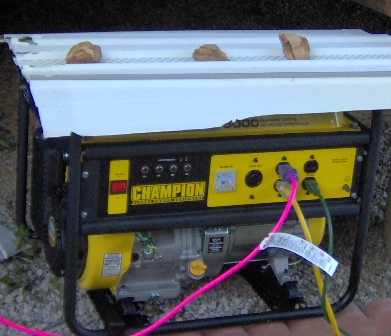 From a lowly mouse to the spectacular explosion of a transformer, from ice storms to tornados, or as seen this week with Hurricane Sandy; from flooded power stations to trees strewn everywhere, there is no shortage of issues that can knock ones power out. In most cases power is restored within hours though in some cases one might be looking at days or weeks. Fortunately we have these things called generators which can either power a few needed items up to a whole house.
From a lowly mouse to the spectacular explosion of a transformer, from ice storms to tornados, or as seen this week with Hurricane Sandy; from flooded power stations to trees strewn everywhere, there is no shortage of issues that can knock ones power out. In most cases power is restored within hours though in some cases one might be looking at days or weeks. Fortunately we have these things called generators which can either power a few needed items up to a whole house.
While generators (coupled with some routine maintenance & exercising) are great for short term usage, when one starts looking at multiple days there are some things to be aware of. Here are some of our lessons learned & tips from our experience of 10 days with no power…
Maintenance:
You need to change the oil – most brands I know of state every 100 hours which is a little over 4 days. If you let it go to long it turns to sludge & no longer can lubricate the parts causing the engine to seize. If 100 hours doesn’t sound like much, consider at 3/4 load it is the equivalent of driving your car over 6000+ miles.
Check & clean the air filter at this time also as all combustion engines require air to run properly. While most “commercial” versions have an hour meter on them, most regular ones do not so try to approximate when you are getting close. Just remember 100 hours is the maximum & it won’t hurt to do it sooner.
Let it rest:
In order to limit the maintenance & fuel needs, it can pay to let it rest. As mentioned in our top ten tips for generators consider letting it run for 4 on & 4 off or a combination that works with your schedule & needs. The food in the refrigerator & freezer should not go bad with that schedule & it has plenty of time to bring it back down. One popular one going around is 8 on & let it rest.
Make sure you turn the breaker off or unplug the cords before powering it back on. Once it is purring along you can start drawing power from it again. Trying to start one with everything wanting power can prevent it from starting properly & cause issues.
Keeping it fueled:
Fuel is a major concern and made worse when you have to wait for hours – know your usage & have enough fuel cans to make sure you can make it through a day or more. The first few days are generally the hardest in cases of a natural disaster, but it generally gets a lot easier as time & resources are brought in.
While some view siphoning fuel from a car as a good backup, it is harder with today’s cars that have “anti-siphoning” pieces built in. You should also try to make sure it is from a car with fresh gas in it (ran low & refueled within last 14 days) as the ethanol used likes to absorb moisture. While the cars do have fuel filters, most generators do not have one for moisture though yours hopefully has one for other containments.
Secure & Cover:
A stolen generator or one where the electrics gets fried during a rainstorm isn’t going to do you any good, so make sure you secure it & help protect it from the rain when needed. Please do not place it near any open windows, intakes, or even worse; inside your house or garage as the fumes can severally sicken or kill you.
Balance & Conservation:
Does it really matter that you left a charger plugged in while the generator is running – probably not as the generator will be burning fuel no matter what. With that said, the less items or draw there is on the generator, the less fuel it will use. One should also try to balance the loads so that they don’t find out that while the generator was running along just fine, your refrigerator & freezer weren’t because they tripped a breaker.
Additional Thoughts:
While one hopes no one has to go through something like this, the fact is you probably will once in your life. For those that are better prepared for something like this, the easier it is to handle. With that said with some common sense& taking some personal action you can & will pull through.
For more tips, tricks & checklists – be sure to check out our articles on Disaster Preparation & Recovery
